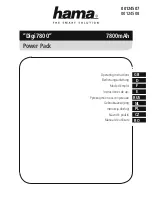
The PDS-375 TR Power Supply™ page 7
3 Connect the System to a DMX source via the DMX Input and connect power
4 Set the system’s DMX Address to the desired starting address value
AAA
5 The 6 connected CB fixtures will respond as follows:
CB Fixture # 1 = DMX address
AAA, AAA+1, AAA+2
CB Fixture # 2 = DMX address
AAA+3, AAA+4, AAA+5
CB Fixture # 3 = DMX address
AAA+6, AAA+7, AAA+8,
etc.
Pass Thru Mode
In
Pass Thru
mode
, the system will convert all the DMX values to CK Data protocol, and
send that CK Data (with 24V power) to all 12 outputs. This mode is useful when powering i-
Color Cove fixtures which have local address switches for each light. The Pass Thru Mode
can also be suitable for CB fixtures when using the CTI PDS-375 TR in a system requiring
Zapi addressing schemes, such as when being used in combination with other Color
Kinetics™ power supplies like the PDS-150™
Pass Thru Mode is selected whenever the DMX Address switches are set to all 0s (000) and
the Config Switch is set to 0
Stand-Alone Effects Mode
In
Stand-Alone Mode
the PDS-375 TR will run various pre-programmed effects without need
for a console. This is very useful for events like parties or trade shows, where a constantly
running program is desired without the use of a console or show programming.
The unit is placed into Stand-Alone Mode using the Config BCD switch. When the unit is in
Stand-Alone mode, the DMX Address switches become Effect controls. Different Stand-Alone
Effects are selected via different setting combinations of the DMX Address switches and the
Config switch
Configuration Switch Settings for different Stand-Alone Effects
0
No Stand-Alone function. The System will operate normally in Pass-Thru or CB
Modes, depending on the DMX Address switch settings.
1
Fixed Color. The DMX address BCDs are used to adjust the red, green and blue
components. DMX 100s controls the red (0 is off and 9 is full), DMX 10s controls
green and DMX 1s controls blue.
2
Color Wash (forward). The color wash effect moves sequentially around the
spectrum of colors (Red, Magenta, Blue, Cyan, Green, Yellow & White) repeating
the same cycle over and over again at user definable speeds. The speeds are
controlled by setting the DMX 10s & ones to 1 of 48 possible settings. The
following lists their settings and approximate fade times.
0 .25
sec
1 .3
sec
2 .4
sec
3 .6
sec
4 1.25
sec
5 2.55
sec





























